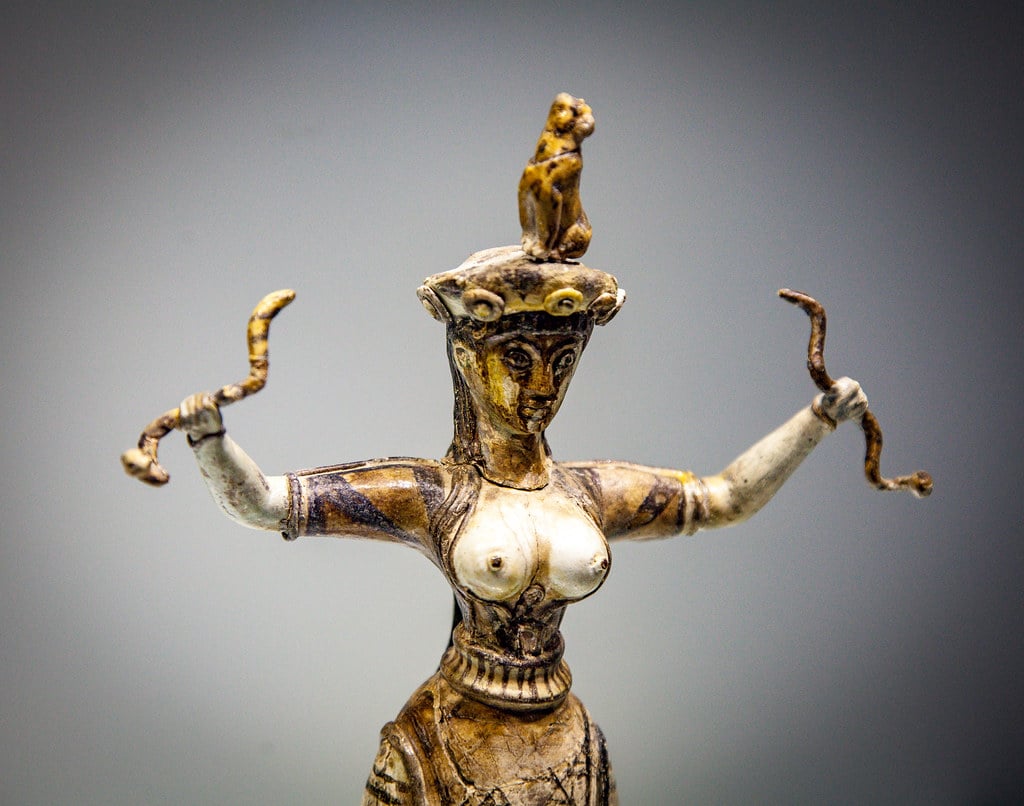
Since the discovery of the so-called Minoan ‘Snake Goddesses,’ it has been debated whether British archaeologist Arthur Evans’ ideas and overstatements about Minoan culture were right. Contemporary research focuses on whether there was polytheism in Minoan Crete and what the connection of the Minoan religion with later Greek myths was.
By Dimosthenis Vasiloudis
Snake as a Symbol Across the World
The snake is one of the oldest creatures on earth, with many peoples and cultures imprinting it in different arts, religions, and myths. It is a symbol of the primordial, of the creation, of eternal movement, primary essence and energy of the universe, as well as of the dead and the Earth goddesses or ‘Mother goddess’ of the chthonic prehistoric cults.
It was precisely this connection with chthonism, matriarchy, and the opposition to the “Olympian,” anthropomorphic, polytheistic world of the gods of Homer and the historical Greeks that the religio-historical “Cambridge School” sought. Its heyday coincided with the discovery of Minoan culture. Today, however, these hypotheses have only been confirmed to a small extent. The original Proto-Hellenic or pre-Hellenic precursors of the ancient Greek religion had yet to reveal many details and secrets.
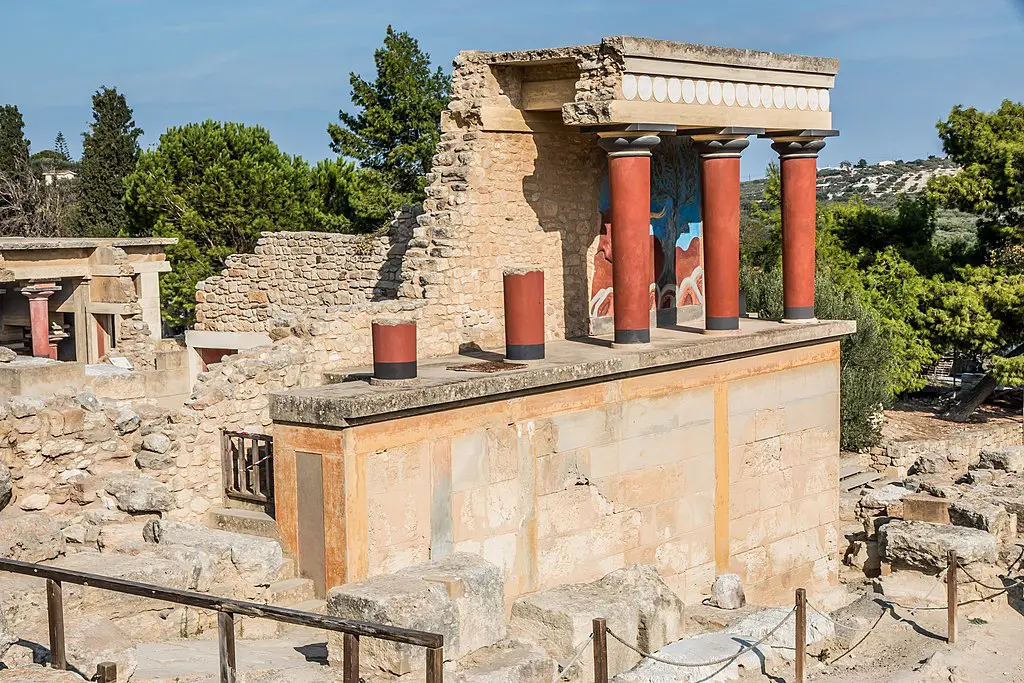
The Minoan ‘Snake Goddess’ Figurines
The “Snake Goddess” figure was singled out by scholars for particular attention and was thought to occupy a more significant place in Minoan religion, art, and society.
The faience figurines identified as the “snake goddess” were discovered in 1903 by the British archaeologist Sir Arthur Evans in the so-called Temple Repositories at the palace of Knossos on the island of Crete. They are now on display at the Heraklion Archaeological Museum. We also know that faience symbolized the renewal of life in old Egypt.
It was 1921 when after his publication of the first volume of The Palace of Minos, the two main snake goddess figurines came to wider attention. Both incomplete and restored by Evans, they date to practically the end of the Neo-palatial period of Minoan civilization at around 1600 BC. It was Evans who called the larger of his pair of figurines a “snake goddess,” the smaller of which was referred to as a “snake priestess.” Since then, it has been debated whether Evans was right or whether both figurines depict priestesses or even the same or distinct deities.
There are three Knossos figurines in total. The larger depicts a woman who has prominent bare breasts and snakes crawling over her arms and up to her cylindrical crown at the top of which a snake’s head rears up. The figure lacked the body below the waist, one arm, and part of the crown before the final restoration. Her dress includes a thick belt with a “sacred knot.”
The smaller one lacked its head and the proper left arm as excavated. As restored by Evans and his colleagues, the figure seems to hold two snakes around its raised hands and on its head, there is a crown consisting of a cat or panther with separate pieces found by Evans in the same pit. Recent scholars criticize this restoration.
A third intermediate-sized figure is broken off at the waist, but the lower part is comparable. The cist also contained another arm that might have held a snake.
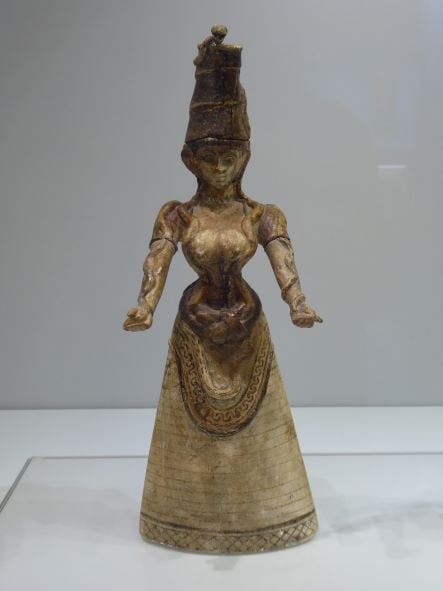
Other Kind of Minoan Snake Goddesses
Archaeology research also brought to light some later (Post-palace period) terracotta offerings, typified by the Poppy Goddess with raised hands and snakes around them, as well as snaked heads rising from the diadem or headdress.
Another later bronze figurine, found in Troas (Minor Asia) and now kept in the Neues Museum of Berlin, depicts a Minoan figure, probably a worshipper rather than a deity, with three snakes on her head. The one breast visible has a prominent nipple so is intended to be bare.
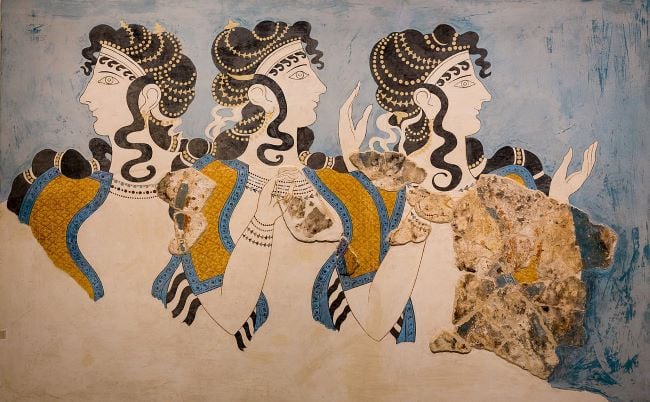
Fertility Deity, Heroine, or Just a Worshipper of Minoan Cult?
The Minoan civilization in all its particularities seems to always have in mind every manifestation of the female gender.
It is no coincidence that perhaps the most characteristic image of the Minoan civilization is this female ‘deity’ who tames snakes with dynamism and puts forward her breasts without hesitation, a characteristic breakthrough if we think about the later ancient Greek tradition.
At the same time, women in Minoan Crete often served the religion as priestesses. The fact that ‘deities’ or priestesses are sometimes depicted topless in iconography does not mean that this is how ordinary, everyday women also went about, and we do not have sufficient evidence for supposing this.
But women were not only goddesses and priestesses for the Minoans. As in every human society, they were also mothers, the beginning of the chain of life and continuity of Crete, and this made them remarkable social factors. In a society with a possibly matrilineal (and not exactly matriarchal) structure (a common phenomenon in prehistory), the Minoan woman enjoyed the appreciation and respect of men and took part in many social events.
Arthur Evans’ Interpretation of Matriarchal Crete
The snake goddess is one of the primary pieces of evidence supporting the view that women dominated Minoan culture. The reasons for this view were raised by Arthur Evans himself. It is obvious from the model of Minoan religion devised by Evans that he was influenced by the theories put forward by James Frazer in The Golden Bough (1890), that prehistoric religion centered on a dominant fertility goddess, and the rebirth symbolized the decay and regrowth of vegetation.
Evans was certainly aware of the prevailing views of the existence of the Mother Goddess in the Prehistoric period, and so when the Serpent Goddess came to light in 1903, he not only recognized her as a “goddess” but also claimed that she was worshipped by the Minoans as an aspect of Mother Goddess. Evans thus provided the basis for the argument that the Minoans lived in a matriarchal society.
The concept of a prehistoric matriarchy was introduced in 1861 when Johann Jakob Bachofen published Mother Right: An Investigation of the Religious and Juridical Character of Matriarchy in the Ancient World.
The term is most often used to refer to theories of prehistoric matriarchal religions that were proposed by scholars such as Jane Ellen Harrison and Marija Gimbutas. It was later popularized by second-wave feminism. In the 20th century, a movement to revive these practices resulted in the Goddess movement.
Both Evans and those excessively speculative ideas have been criticized by modern anthropologists and religious studies scholars.
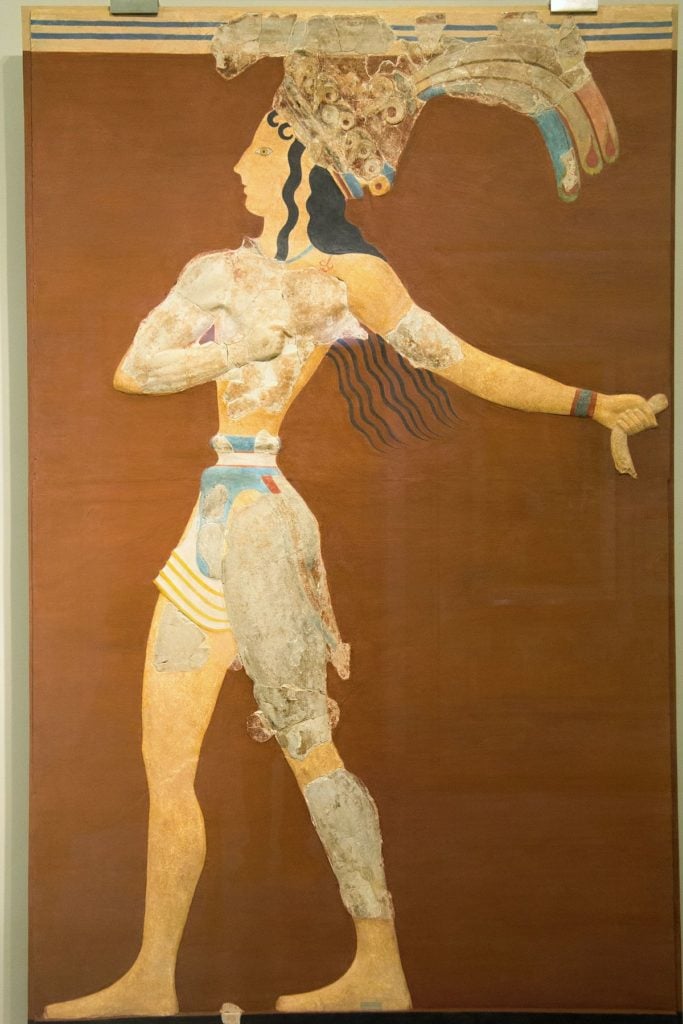
Modern Interpretations
Contemporary research around the Creto-Mycenaean religion has been greatly enriched in the last decades. We can now safely suppose the existence of a polytheistic system of worship in Minoan Crete, a gradual appearance of new forms of worship during the Palatial period and their evolution, as well as the significant existence of specific links and motifs with the later archaic and classical Greek mythological tradition.
Walter Burkert (Greek Religion, 1985) believes that the serpent figurines are probably related to the Paleolithic traditions regarding women, maternity, fertility, and domesticity.
The figurines have also been interpreted as showing a mistress of animals-type goddess and as a precursor to Athena Parthenos, who is also associated with snakes, suggestions made both from Martin P. Nilsson (A History of Greek Religion, 1949) and Daniel Ogden (Drakon: Dragon Myth and Serpent Cult in the Greek and Roman Worlds, 2013).
Martin P. Nilsson also noticed that in the Minoan religion, the snake was the protector of the house. It later also appeared in Greek religion and signified wisdom and fertility within the Greek Dionysiac cult.
However, Geraldine Gesell in her book Town, Palace, and House Cult in Minoan Crete (1985) argues that the snake goddess was not a household goddess, as no snake goddess has ever been found in a true domestic context. Rather, the snake goddess had the broader function of universal Mother or Earth Goddess and was thereby principally a fertility deity.
Emily Bonney regards the figures as reflective of Syrian religion which had a brief impact on Crete at the time when the elites at Knossos emulated Syrian iconography as an assertion of their access to exotic knowledge and control of trade.
Hans Georg Wunderlich (The Secret of Crete, 1994) related the snake goddess with the Phoenician Astarte. She was the goddess of fertility and sexuality, and her worship was connected with an orgiastic cult. Her temples were decorated with serpentine motifs. In the related Greek myth of Rapture of Europa, who is sometimes identified with Astarte in ancient sources, a Phoenician princess is abducted and carried to Crete by Zeus.
Evans tentatively linked the snake goddess with the Egyptian snake goddess, Wadjet, but did not pursue this connection. Statuettes similar to the “snake goddess” type identified as “priest of Wadjet” and “magician” were found in Egypt.
Barry Powell suggested that the “snake goddess”, reduced in legend to a folklore heroine, was Ariadne, who is often depicted surrounded by Maenads and satyrs. According to Walter Burkert, similar scenes with ecstatic dances of devotees and Epiphanies of female deities are often depicted on Minoan and Mycenean rings and seals.
While the statuette’s true function is somewhat unclear, her exposed and amplified breasts suggest that she is probably some sort of fertility figure.
Possibly, when the Minoan Linear A script is deciphered, as was the Linear B which provided us with a lot of information and theonyms, a different view on the Minoan civilization will emerge. Until then, the visual evidence alone describes an exotic, maritime, and peaceful society centered on large, palace-like buildings which seem to have served primarily, judging from the huge storage areas, as collection and distribution centers for a well-organized system of local agricultural production and extensive trade.
We do not know exactly who the leaders were, but circumstantial evidence indicates that women played a dominant role in Minoan religion and perhaps also in Minoan society.
See all the latest news from Greece and the world at Greekreporter.com. Contact our newsroom to report an update or send your story, photos and videos. Follow GR on Google News and subscribe here to our daily email!



